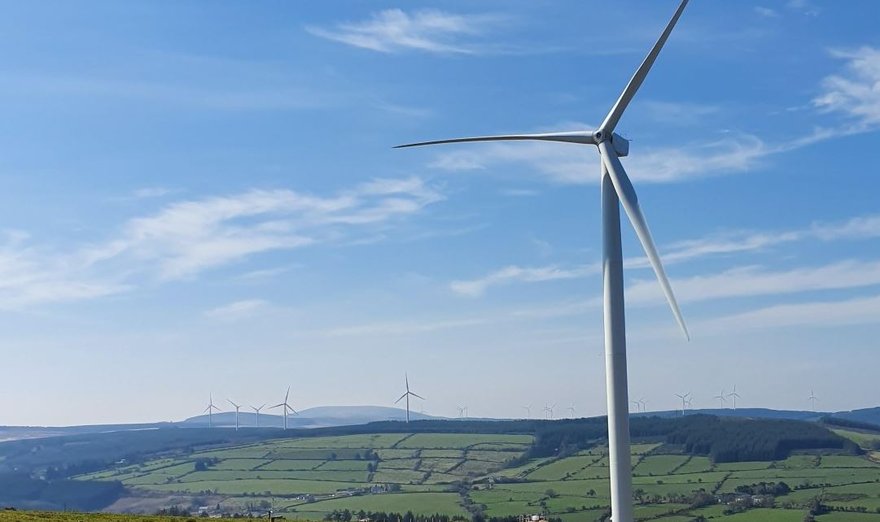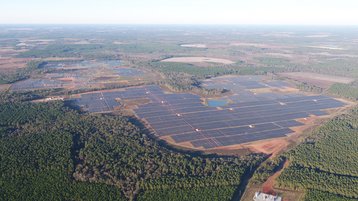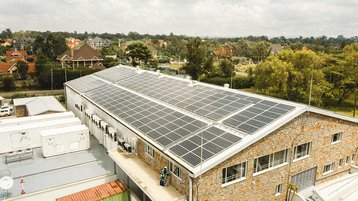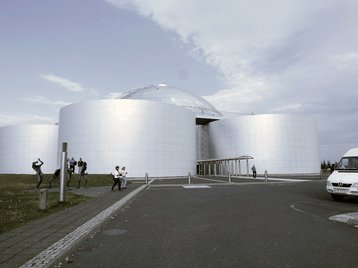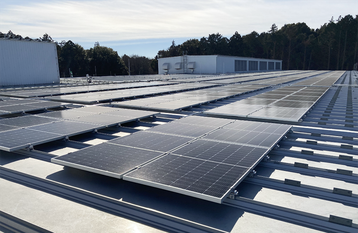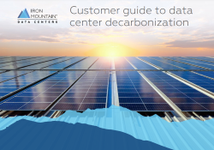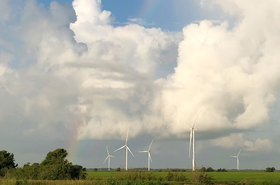There are few buildings more energy intensive than data centers. As densities increase, single facilities can now eat up more energy than whole towns.
To offset this and ensure their green credentials, many companies are signing Power Purchase Agreements (PPAs), which help bring new renewable energy projects online and help organizations claim their operations are sustainable.
Data center hyperscalers such as Meta, Amazon, Microsoft, and Google are some of the largest corporate buyers of renewable energy in the world, each having procured multiple gigawatts of renewable energy and investing in hundreds of renewable energy projects globally.
But what are PPAs, and what do data center operators need to know about them?
What is a Power Purchase Agreement (PPA)?
Power purchase agreements (PPAs) are a way for companies, including data center operators, to ensure the energy demands of their operations are covered by an equivalent amount of renewable-generated energy being generated.
“In its simplest form, a power purchase agreement is a way for large energy consumers to meet their sustainability goals by receiving energy attribute certificates from renewable energy projects, and do it at scale,” explains Joey Lange, managing director of the renewables team at energy consultancy firm Edison Energy.
The specifics will vary depending on the project, location, and the regulations of the local energy market, but at its simplest, a company will form an agreement with an energy provider to invest in a renewable energy project such as a wind or solar farm and then procure the output of that facility to cover some or all of the energy requirement of one or more data centers, once the project is live.
There are multiple types of PPA. Onsite PPAs will install renewable energy infrastructure at a company’s location where it can feed power directly. These are less common and usually smaller scale than offsite PPAs, in which companies procure the energy from large renewable plants at other locations.
Greg Kavanagh, sales director at Shell Energy UK, tells DCD the company's on-site PPAs are often in the 500kW to 3MW range and come from rooftop solar panels or small-scale wind turbines. Limited on-site space can be an issue around deployment, as can weight on buildings.
Off-site PPAs are larger - up to hundreds of MW per deal - and can be broken down into physical PPAs and Virtual PPAs (VPPAs aka financial PPAs). Physical PPAs will see companies agree to off-take the output of specific projects i.e. a particular wind farm, while VPPAs will see companies buy renewable energy from an energy provider’s portfolio but not attributed directly to specific projects.
If investing in a particular project, companies can procure the entirety of that site’s output or a portion of it. PPAs are usually for wind or solar projects, but hydroelectric, biogas, geothermal, and even nuclear power can be covered under PPAs. Deals are usually financing development of a project, so are long-term agreements; 10 years is not uncommon.
It’s worth noting that any offsite PPAs, even if they are attributed to particular renewable projects, do not directly power data centers. The project’s output is pumped into the grid and mixed with all other energy plants, dirty and clean; PPAs merely ensure an equivalent amount of a customer’s agreed energy demand is being generated by renewable sources.
In many instances, companies still have to procure energy through their utility provider alongside a PPA. However, in ‘sleeved’ PPAs, the utility provider will handle the PPA energy and supply additional power as required.
The specifics of an agreement will vary depending on the market you are aiming to operate in. Pricing dynamics of a PPA also vary.
Deals can be price-fixed for the duration of the contract, fixed with set or variable escalations, fixed but include settlements between different parties depending on wholesale price, indexed to energy markets with various discounts, and floors & ceilings, or a combination of each.
The structure of the deal will depend on the amount of risk each party is willing to take on and the nuances and regulations of the local market. Fixing prices provides long-term cost visibility but may end up more expensive in the long term compared to market prices, while variable ‘floating’ PPAs tied to market energy prices and/or hedging are more unpredictable but offer a greater chance for lower prices if the dynamics are favorable.
The World Business Council for Sustainable Development has published an in-depth guide to the various pricing structures of PPAs that is worth a read.
Why do companies need PPAs?
Customers want to decarbonize their supply chains (including their data center provision), and operators are setting themselves sustainability targets or meeting targets imposed on them. Given these drivers, digital infrastructure has become the largest global customer for PPAs.
Hyperscalers procure gigawatts worth of renewable energy. Likewise, telcos are major purchasers of PPAs as they look to offset both their data center footprint and their mobile network operations. Even enterprises such as State Farm and eBay have signed PPAs to cover their operations, of which on-premise data centers can be a large – if not the largest – proportion.
“The large tech players are certainly still driving a lot of the renewable purchases and taking a lot of the supply in the market at the moment,” says Edison’s Lange. “We have seen a number of enterprise clients using PPAs to cover that data center load because it's such a large part of their overall load.”
Colo firms including Equinix and Digital Realty are large buyers of PPAs, as are the likes of QTS, Scala, STT GDC, Supernap Thailand, Sify, Element Critical, and OVH. But Lange says colos procure PPAs less often than hyperscale or enterprise operators.
“Equinix is dedicated to sustainability and reducing its carbon footprint, with PPAs being a key part of its approach," says Bruce Fransden, director, project and program management at Equinix. "Our customers want their infrastructure to be powered by renewable energy, and this trend has driven some of Equinix's decisionmaking around renewable energy and influenced its approach to PPAs."
"We started down this journey and started looking at pathways to renewables in earnest as far back as 2015," adds Arron Binkley, VP of sustainability at Digital Realty. "Electricity is the largest contributor to Scope 2 carbon emissions for data centers, so anything we can do to decarbonize that is going to be the most impactful."
"Our customers are very much in favor of telling their customers that they are being hosted in data centers that are working on PPAs and offsetting their usage by certificates," adds Vinh Thong ‘VT’ Le Nhut, operations director at Digital Realty.
PPAs for colocation vs cloud and enterprise
Colo firms are buying energy on behalf of multiple customers, not all of which will have particular requirements or interest in procuring renewable energy – or the desire to deal with any added costs or accompanying carbon accounting requirements.
“In the case of colos, the load that you're trying to cover with the renewable energy purchase is typically on behalf of their customers,” says Edison’s Lange. “Do the terms of their agreements with those tenants align with the term of a 15-year PPA? That’s a big question we often address upfront with our data center clients; just how confident are you in your load projections and when do you actually need this project to start generating?
Another is what is your relationship with your tenants,” he says. “How are the cost and benefits of a PPA passed on, and are they willing to take that cost? We hear from data center companies that their tenants want renewable energy and they want it at a better or comparable prices to brown power; right now in this market, that's really not possible.”
Larger colocation companies – especially ones with hyperscale or long-term enterprise customers – can probably be confident in their load projects. With smaller retail colo customers and providers, the picture can be more difficult.
“For colocation providers like Equinix, renewable energy PPAs can be more complicated compared to enterprises and hyperscalers that are the end-users of that energy,” says Equinix’s Fransden. “Colocation providers must balance several competing priorities, including their own sustainability goals vs those of their customers and both parties' desire to keep energy costs low.
“As part of the economic analysis, Equinix must decide whether to pass on the additional cost to its customers in the form of higher prices, or to absorb the cost and maintain competitive pricing. To balance these competing priorities, Equinix works closely with its customers to understand their energy needs and to find solutions that meet both parties' needs.”
What to look for in a PPA project
Data center operators with multiple facilities in multiple markets will likely need to deal with a number of PPA providers in order to achieve their sustainability targets on energy use. But it isn’t uncommon to see operators partner with the same renewable project developers for multiple PPAs.
“Large buyers will have four to six different developers that they work with on a routine basis,” says Edison’s Lange. “We want to build a relationship where we can see their pipeline early and have negotiations. Then you can build that trust with them and have an open-book relationship around costs which is really critical to these long-term large renewable goals versus just a one-time contract.”
Fransden says Equinix has taken a “flexible” approach to PPAs and doesn’t have a specific preference for either small-scale or large-scale projects. “We evaluate each PPA opportunity based on its individual merits, including factors such as developer reputation; cost; risk factors; impact on the local community and environment; and overall alignment with Equinix's sustainability goals,” he explains.
Digital Realty's Binkley tells DCD the company is generally looking for projects that are in the same grid region where its facilities operate, as it allows the production of energy to be tied with the consumption of energy in the same grid.
"All things equal, we would prefer to transact in dirtier grid regions rather than low carbon grid regions," he says. "We want to not only add renewables but add them where it has the biggest impact in terms of displacing dirty power from fossil fuels. But there can be trade-offs with economic competitiveness and availability of projects."
"We don’t have any preferred partners per se, however, we do tend to gravitate towards partners that have proven track records of constructing and bringing projects online consistently, as well as those that offer long-term support throughout the life of the contract," Binkley adds. “We've transacted in multiple jurisdictions, multiple countries with multiple types of projects over a number of years, so we feel good that we can come to a developer and say, we get deals done, and we're not a one-time buyer in many cases.”
Shell's Kavanagh says customers look for a reliable partner to support their project needs: "It’s not just about a cheap price or getting an agreement over the line quickly, it’s about understanding what option works most effectively for them – not just in the short-term, but in the long-term too – as well as having an expert in place to help navigate through the complexities of the market."
While many data center operators will be looking to procure energy for existing facilities, companies should also be considering renewable energy in tandem with new developments.
Franek Sodzawiczny, founder and CEO of KKR-backed Global Technical Realty (as well as both Zenium and Sentrum), is currently developing data centers in the UK and Israel with his new firm. The company broke ground on the first of three 13.5MW, 5,400 sqm (58,000 sq ft) buildings at its Slough campus in January 2022, and the company is eyeing potential PPA partners with an eye for the future.
"For a new data center facility, even if they’re up and running in six months, will need a stable and predictable load before they can get a PPA in place," he says. "Essentially you are agreeing to purchase a pre-agreed amount of power, and during at least the first six months of a data center coming online, the usage is usually sporadic, ramping up for a while as the halls come online.
"We are already investigating some renewable assets, due to go live Q4 2023, and looking to procure. Typically, you are looking at a lead time of a nine months minimum from the start of inquiry to a PPA going live," he adds. "The most sensible approach is to arrange a ‘standard’ contract until the load is stable and then look to procure PPA from there, rather than run the risk of paying for power you don’t utilize."
PPAs more common in US & Europe
Climate and regulations play a big part in the PPA sector, and markets differ depending on where you aim to locate a project.
PPA markets in Europe and the US are well-established but the regulatory environment can vary between different markets. In the US regulations can vary state-to-state and also depend on the transmission system where you aim to place a renewable project. This means that even a project in one state can be in two markets, if it covers two interconnections.
In Europe, the costs are likely higher, but grids will cover the whole country, meaning it can be easier to take a wider approach. There is, however still variation between each market, even within the EU.
“We have big operations in countries like France and Germany,” says Digital Realty’s VT, “and we know that it is very difficult to find PPAs in these markets, as opposed to the Nordics or Spain for instance. The market in Europe has become mature in the last three to five years, but it is not as mature as in North America."
“In the Asia-Pacific region, the PPA market is still in its early stages, and the regulatory environment for PPAs can be more challenging compared to the US and Europe,” says Equinix’s Fransden.
“However, the cost of renewable energy in that region has been decreasing, making it more accessible. We are also working with a group of companies in Australia evaluating projects for an aggregated PPA in that market."
PPA trends – Seller’s market for the foreseeable
PPA costs have been increasing rapidly in recent years, with 2022 seeing a significant spike in prices – up to 50 percent in some European markets. This has partly been driven by high demand for new projects pushing up against supply chain constraints across materials, labor, and transportation, regulations slowing down new project authorizations and interconnection permits, along with the war in Ukraine.
“2020 was probably the best year from a buyer's perspective to be in the market; PPA prices were low and demand wasn't exceeding the supply,” notes Edison's Lange. “The pendulum has definitely since swung towards the supply side.”
Equinix’s Fransden tells DCD: “Increased demand has led to a seller's market, where developers and owners of renewable energy projects have more bargaining power and can command higher prices. While this trend has been particularly pronounced in markets such as the US, it is becoming prevalent in all markets where PPAs are an option.”
Edison’s Lange notes that more developers are entering the space while the existing players are ramping up their portfolios ‘fairly drastically’ in part due to the Inflation Reduction Act helping the economics of certain projects. Prices largely leveled off by the end of 2022 as some of these issues eased, but are yet to drop noticeably. This is partly due to a large supply and demand imbalance for solar panels.
However, as more panels begin to be manufactured locally – Microsoft is backing one effort to build solar panels in the state of Georgia – costs may come down. During 2022 when energy prices reached record highs, the price of PPAs may have been more bearable, but as the wider market calms down, companies may begin to balk at paying high PPA prices.
“I think something has to give at some point,” says Lange. "There's going to be a point where corporates just stop saying ‘we can bear that cost'.”
Market dynamics mean ‘net new’ desires limited
Almost all PPAs are for ‘net new’ projects i.e. investing in projects that are not yet complete, as opposed to off-taking energy from already-operational projects. However, looming target deadlines and capacity crunches mean new projects aren’t always viable, especially in the current market.
“The vast majority of our clients still have a requirement for new-build renewable energy – sometimes termed 'additionality' – because companies want to be able to make the claim that they're adding additional renewable energy to the grid,” says Edison’s Lange.
“With the current market, we have started to see that change a bit. Some companies with near-term goals of needing renewable power by 2025 that are falling behind, may say the overall goal is additional projects, but are comfortable signing a short-term PPA on an existing asset to bridge the gap. This wasn’t common several years ago, but is now part of companies’ strategies.”
Equinix’s Fransden says his company’s focus on new projects “provides a high impact and helps increase the reliability of the local grid.
“While our current renewable energy PPA portfolio consists of only new build projects, we will consider existing renewable energy projects as opportunities present themselves,” he adds.
Digital Realty is also focused on net new projects: “We want to have that additionality impact of bringing new renewables onto the grid,” says Binkley. “We've been able to find deals, for the most part, where we want them. Where we've had issues have been typically where the deals are there, but the price point is just not attractive, or in emerging markets where there isn't a mature renewable market.”
24/7 matching in PPAs
By its nature, renewable energy can be fickle. The sun doesn’t always shine and the wind doesn’t always blow, but the constant energy demand of data centers means that even companies with PPAs will inevitably see the grids powering data centers relying more heavily on fossil or non-renewable fuels during these lulls.
To counter this, some companies have begun to explore the use of 24/7 (or hourly) matching PPAs, which look to ensure that operations are covered by renewable energy on a constant basis, even when particular renewable projects might be operating at a lower efficiency.
These may include over-provisioning on more projects, investing in different energy types, utilizing energy storage systems, or buying renewable energy from the wider market. Microsoft and Google have previously made efforts to ensure at least some of their facilities have around-the-clock 100 percent carbon-free matching. Colocation firm Bulk has also signed a matching PPA, as has Iron Mountain.
Google has been very open about the energy mix of its facilities, allowing customers to make decisions about where to host workloads to ensure they are as green as possible, and has been working on migrating certain parts of its own workloads between different facilities to try and achieve the greenest operations.
Microsoft also publishes the energy mix data of its Azure cloud regions.
Iron Mountain is also using carbon tracking for greater visibility in the energy mix of its facilities with ClearTrace; Aligned Ascend, T5, and Corscale are doing something similar with nZero (formerly Ledger8760).
However, 24/7 hourly matching can be difficult, and Edison’s Lange says investing in an entirely new project in a dirtier grid can have a larger overall impact compared to a 24/7 PPA in a grid that is largely already renewable.
“We've had a lot of discussions around that. Does it matter if you have every hour of the day covered with renewables, or does it matter that you're buying renewables from a dirtier grid and making the biggest carbon impact possible?”
“There's no right or wrong; both are good. That idea of emissionality – making the largest climate impact – is certainly a lot easier to do than 24/7,” he adds.
Lange notes that battery storage is becoming increasingly common in certain markets, such as Texas’ ERCOT grid, and can be key for 24/7 matching: “In every instance, we have a discussion with the client and the developer around whether it makes sense for the client to be part of a battery storage contract as well."
"There's certainly carbon benefits to batteries from a time shift perspective and when that energy gets generated and put onto the grid at more carbon-intensive times. But it comes at a steep cost.”
Equinix tells DCD it is ‘not currently pursuing’ a 24/7 strategy, but notes the growing interest in the area. “Hourly-matched renewable energy PPAs present the challenge of a much more complex procurement process, higher administrative burdens, and sophisticated reporting scheme,” says Fransden.
Likewise, Digital Realty tells us 24/7 matching is something the company is ‘closely investigating and tracking’ and is part of industry groups working to improve hourly emissions data tracking. “Currently, however, there are limitations in many markets in terms of getting visibility into hourly emissions, which is a vital part in making 24/7 energy matching work,” Binkley says.

